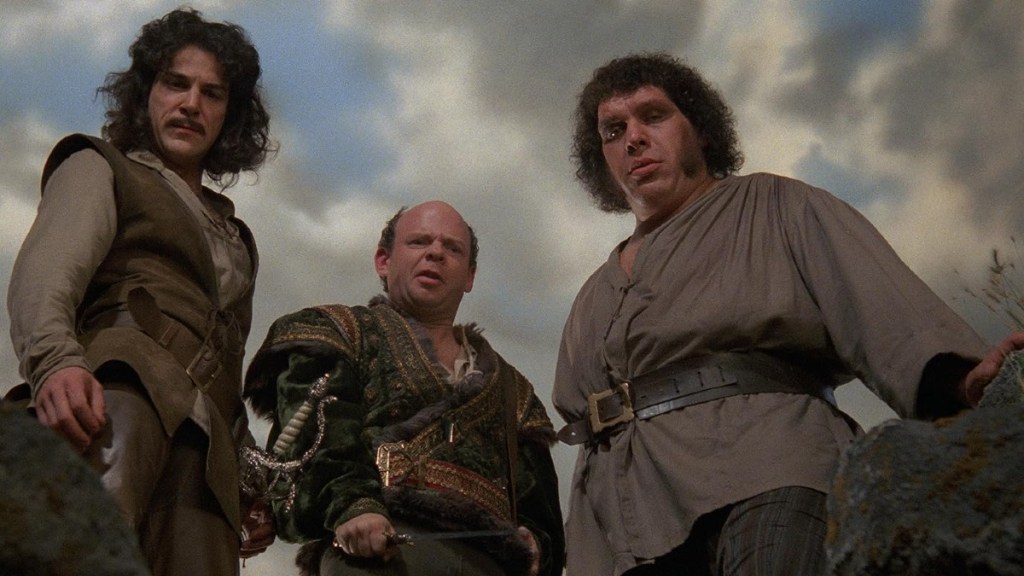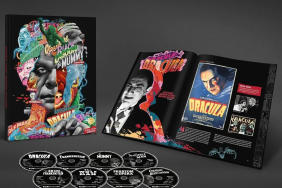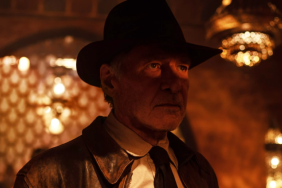Contrary to the way people talk about it, the Princess Bride wasn’t a bomb upon release, but a modest success, grossing $30 million on a $16 million budget. The issue, perhaps, is that it should have been bigger, given the way people have come to love it and regard it as a classic today. Rob Reiner, in several interviews, blames the marketing — the Criterion disc includes the domestic and international trailer, along with some TV spots, to let the viewer decide.
Two things stand out. One is that Andre the Giant, who was red-hot at the time due to his recent WrestleMania III main event against Hulk Hogan, wasn’t heavily promoted as being one of the stars. (That was what brought young Luke to the cinema!) The other is the music. Mark Knopfler’s score is the weakest part of the movie, and always has been, playing to the sentimental surface appearances that Fred Savage’s character hates and is initially put off by. And all the trailers use it — it thematically undercuts the comedy beats they’re trying to sell. Did anyone tell Knopfler it was meant to be funny?
Aside from that, the trailers aren’t misrepresentative, but they form an impression, held by my wife for some 13 years until I was able to insist this was a work assignment, that the movie was some sort of stereotypical “chick flick” to be avoided. A decade into our marriage, she has now finally watched it and seen the light.
Double Feature
For the 4K Criterion set, the included Blu-ray is the same one released in 2018. It’s pretty thorough, so the choice is understandable, but it might make those who already have it think twice about upgrading. The 4K disc itself holds just the movie and the 1997 laserdisc commentary track, featuring Reiner, writer William Goldman, producer Andrew Scheinman, Billy Crystal, and Peter Falk. Unlike the actors on the Time Bandits commentary, Crystal and Falk are included throughout, and don’t just talk about their own scenes, though it’s clear each person recorded commentary separately.
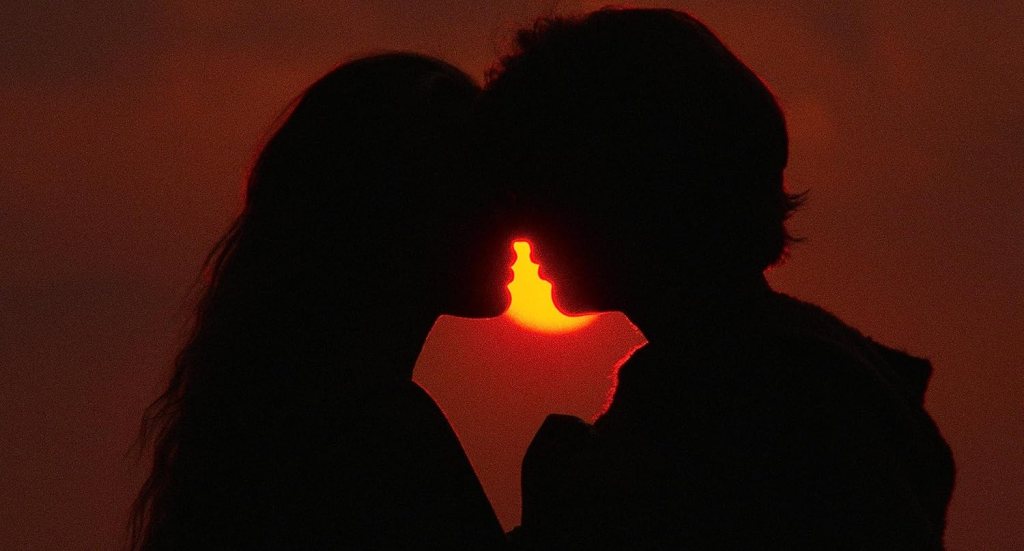
For the benefit of those who don’t own the Blu-ray already, it includes a variety of special features from 1997, 2007, 2012, and 2018, so you can see the actors age before your very eyes. They include most of the extras from previous editions, lacking only the separate solo commentary tracks by Reiner and Goldman recorded for the 1999 DVD. In addition to the 1997 amalgam, the only other “commentary” is a version of the audiobook read by Rob Reiner and abridges so it matches what we see onscreen. Listening and watching that way emphasizes the fealty to source of the book within the movie — as readers of the book know, the wraparound/framing device is a bit different.
The Blu-ray came out in 2018 shortly before Goldman’s death, which adds extra poignancy to the featurette involving his custom tapestry based on the movie, hanging at his house — it’s possibly the last footage of him alive. Less interesting is a Columbia professor essentially going over Screenwriting 101 as regards Goldman’s script. If you’ve ever studied any aspect of screenwriting or read any books on it, none of that will be new.
Inconceivable Omission?
Various interviews with most of the cast over the years are here, along with behind-the-scenes footage that has optional commentary. The only major player missing is Wallace Shawn, who, from everyone else’s accounts, was incredibly insecure about his performance at the time, although certainly by now he must have realized the movie will be his most enduring contribution to pop culture. Here’s how you know The Princess Bride is a classic: had it not become so, more critics would derisively refer to it as My Dinner With Andre the Giant.
An interview with a sword master who didn’t work on the film feels weird, while one with art director Richard Holland makes more sense. Considering the time lapses, some anecdotes get repeated — that’s forgivable, but suggests it might be best not to watch every extra in one go.
Both discs come packaged in a storybook, bound with pages and pictures, and two essays. The first, by Sloane Crosley, is a slightly self-indulgent first-person account of watching the movie with her niece, though she also correctly analyzes many of the story beats that really don’t make sense, acknowledging that it also doesn’t really matter. The second, by Goldman, describes how he wrote the book and defeated his writer’s block for scene transitions simply by pretending it was an abridged version of a much larger book, with “good parts” he could skip ahead to when necessary. It’s an adorable package that looks like a children’s book but isn’t quite…much like the movie itself.
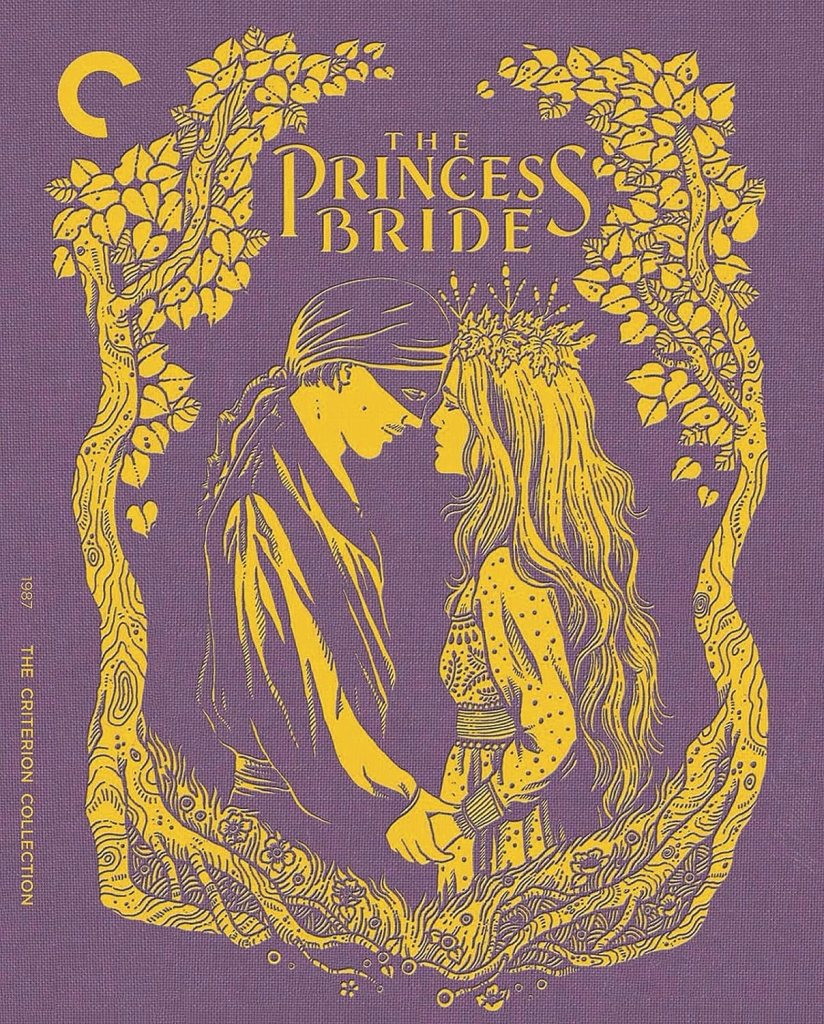
So with all that out of the way, how about the actual movie?
Once Upon a Time…
As many talking heads on the extras suggest, it’s a masterful blend of sincerity and irony, in just the right amounts so as not to undercut each other. Normally only the Muppets pull this kind of balancing act off. As Crosley and Goldman both state, there’s a lot in the story that doesn’t withstand a ton of scrutiny, as plot points frequently involve insane coincidences and sudden plot conveniences. To note an egregiously obvious one, there’s Fezzik (Andre) just happening to find four perfect horses at the end, one of which is big enough for him. There’s a lot more of that throughout — suddenly establishing that death is reversible right when that’s convenient, for instance, or the “holocaust cloak” that just happens to be on hand. Other studio movies would plant seeds of these concepts earlier to have them pay off, but Goldman gleefully ignores that rule.
And here’s the thing: nobody minds! Grandpa (Peter Falk) could be taking poetic license, or making the story up rather than actually reading it properly. So long as the real-world scenes obey the laws of the real world — we’ll forgive the way the He-Man action figure behind Fred Savage sometimes appears in different positions and spots — the fairy tale can make its own rules, and deflect them with fantastically witty dialogue. Every actor is perfect for delivering Goldman’s prose, too, with the possible exception of Andre, though he’s better here than he ever was at WWE promos. It’s dialogue worthy of the stage, and carries the audience through the fact that for a fantasy, this is a really modestly budgeted one. Those ROUSes are actually little people in suits.
He Came, He Saw…
It’s tough to say Cary Elwes was a major discovery since the actor hails from a family of film producers and would have been discovered no matter what, but it’s safe to say he’s never been better before or since. Robin Wright, on the other hand, was — a soap opera star capable of doing a flawless English princess accent and keeping up the fast pace often led by Elwes.
If the movie were made today, somebody would likely complain that Vizzini is not played by a Sicilian, nor Inigo by a Spaniard, or Fezzik by a Turk, as the book had them. (That the movie features real countries alongside utterly fictional ones is never remarked upon.) It would have been quite the loss for posterity — one can safely say that Vizzini and Inigo are the best-known roles of Wallace Shawn and Mandy Patinkin, respectively. Andre’s best-known role will always be Andre, and Fezzik is basically him.
Fun Storming the Castle
As for the 4K, scanned from the camera negative, mastered using the laserdisc as a guide, and approved by associate producer Steve Nicolaides, it looks phenomenal. The deep focus scenes are sharp and clear, every seam on every costume and every bit of peach fuzz Elwes missed when shaving shows up, and the flesh tones, over-pink on some prior copies, look normal again. It’s as close to seeing it on the big screen again as you can get.
Patinkin and Elwes did all their own swordplay, studying every prior fencing movie to make their battle the best one, while Andre had to be doubled for wrestling scenes because he was in too much pain to lift anything. The disc is clear enough that you may notice how the tricks are done. Not that it’ll spoil anything; like with a Penn and Teller show, half the magic is in knowing the trick and seeing how entertainingly it’s done anyway.
You probably didn’t need this movie recommended if you’re reading this, but consider it so done anyway.
Grade: 5/5
